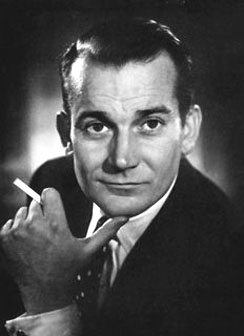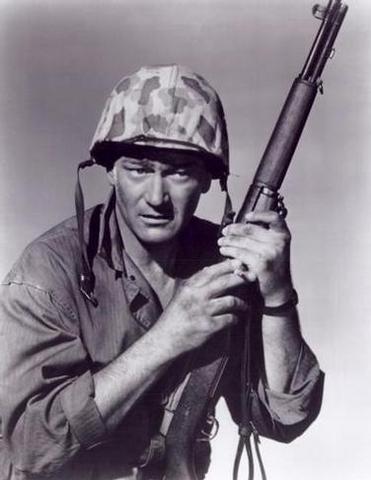
ON THE NIGHT of Sept. 23, 1942, a flight of RAF Halifax bombers from No. 76 squadron struck a German harbour facility on the Baltic Sea.
During the mission, one of the British planes was hit by a burst of enemy flak. Critically damaged and losing altitude, the pilot of the four-engine aircraft skidded the plane into the North Sea. Only three crewmen survived the crash.
The dazed fliers were plucked from the water by the Germans, promptly interrogated and then sent to a POW camp in Selesia where they would remain for the rest of the war.

One of the fliers from the doomed Halifax, a 20-year-old radio operator, passed the many months in stir performing Shakespeare for his fellow inmates. The young sergeant discovered (much to his surprise) that he actually had a flare for the dramatics. After the war, the aspiring thespian pursued his new-found passion and in 1949, landed his first film role in the movie Dear Mr. Prohack. Later, he’d star in such films as The Cruel Sea, Alfie, Trading Places and even the blockbuster hit Raiders of the Lost Ark. That actor’s name: Denholm Elliot.
Of course, Elliot was just one of many celebrities to serve in wartime. Here are some others:

Hollywood and World War Two
A number of famous Americans (and some not-yet-famous ones) joined the U.S. military during the Second World War. For example, William Holden, Hollywood’s so called “Golden Boy” was already a star when he was commissioned as an officer in the Army Air Corps. So was Jimmy Stewart. The 34-year-old idol became a flier and eventually commanded a squadron of B-24 bombers in Europe. One of the men under his command was a then unknown 25-year-old gunner from New York named Walter Matthau.
Mel Brookes wasn’t a flier, but the screenwriter, director and comedian behind movies like Blazing Saddles, Young Frankenstein and Spaceballs did serve as a corporal in the U.S. Army in Europe in 1945. So did Peanuts and Charlie Brown creator Charles M. Schultz. Although drafted in 1943, the aspiring cartoonist was only sent to the front lines in the final weeks of the war. He once joked that only once did he get the chance to fire his weapon at the enemy, but on that particular occasion, had forgot to load it. [1]
Rod Serling, the face of TV’s The Twilight Zone in the 1960s did get to fire his weapon — many times it would turn out. A paratrooper in the 11th Airborne Division in the Pacific, Serling was a veteran of numerous engagements. He even won the Bronze Star and was awarded a Purple Heart. Later he would become a vocal critic of the American war in Vietnam.
Another Hollywood icon who supposedly was wounded in the service was Jack Palance. The Oscar winning actor was also a wartime flier. In fact he reportedly was so badly injured following a B-24 crash that he required reconstructive surgery. Palance said later in life that the entire story was exaggerated by studio publicists. [2]
A handful of American stars chose to do their part at sea. Don Rickles served on the USS Cyrene in the Pacific before he became famous.
Henry Fonda, who had starred in The Grapes of Wrath in 1940, joined the navy after Pearl Harbor and served on the USS Satterlee, a destroyer that was stationed in the Atlantic and Mediterranean. Fonda later was transferred to naval intelligence.
Other stars who went to sea include Kirk Douglas, Tony Curtis and Ernest Borgnine. Carroll O’Connor of Archie Bunker fame was rejected for naval service and instead joined the merchant marine.

It wasn’t the merchant marine, but the United States Marines that included in its ranks a young Lee Marvin. The teenaged future movie star dropped out of school to join the leathernecks and eventually fought on Saipan where he was wounded by Japanese machine gun fire. Most of his platoon was wiped out during the engagement.
One Hollywood luminary conspicuously absent from World War Two’s roll call was the Duke himself, John Wayne. Already in his mid 30s when America entered the war, Wayne was granted a deferment from the draft board due to his age. Republic Studios supposedly worked to prevent him from leaving show business to fight. Wayne continued to make films throughout the conflict and even travelled to war zones to cheer up the troops, sign autographs and urge soldiers to hang in there. In fact, Wayne was once famously booed by Marines fresh from Pacific battlefields after appearing before them dressed in a cowboy costume to give one of his rousing appeals to tough it out. His widow said that his failure to fight in the war haunted the screen legend to his dying day. [3]

British Stars at War
A number of famous Brits took part in the war too.
Star of screen and stage, Richard Burton served in the RAF from 1944 until after the war.
Jack Hawkins, who would star in such films as Ben Hur, Bridge on the River Kwai, Lawrence of Arabia and The Cruel Sea enlisted in the British army at the age of 30 after Dunkirk. He was stationed in India where he was put in charge of entertainment.
Comedian Benny Hill, drafted in 1942, was also involved in entertaining the troops.
Alec Guinness was already acting when he joined the Royal Navy in 1941. He would command a landing craft during the invasion of Sicily.
Anthony Quayle who would star in The Guns of Naverone with Niven and in Damn the Defiant opposite Alec Guinness was an officer in the Special Operations Executive and worked with partisans in Albania.
While not a Brit, James Doohan, who would go on to play Mr. Scott in Star Trek, was a lieutenant in the Canadian army on D-Day. After fighting on Juno Beach at Normandy, the future television star lost a finger after being hit by friendly Bren gun fire. He later would train as a pilot.

Women Celebrities
Several leading ladies also did their part during the war.
Marilyn Monroe was a labourer in a stateside munitions factory when she was photographed on the job by an army photographer working on an assignment ordered by an obscure publicity officer named Ronald Reagan. The future president was assembling on a propaganda piece about women on the home front. The photos were later seen by modelling scouts and the rest is history.
Although raised in the U.K., Audrey Hepburn lived in Arnhem, Holland as a teen in 1940 when the Germans invaded the Netherlands. She ended up helping the Dutch underground as a courier and narrowly survived the devastation the town endured during the Allies’ Operation Market Garden.
Culinary diva Julia Child could have told you what she did in the war, but then she’d have to kill you. The famous television chef spent her early 30s as an assistant in the OSS — first in Washington and later in the Far East. Her service records were declassified in 2008. They revealed that she was responsible for, among other things, sorting cataloging thousands of top secret files.
SOURCES
1. http://en.wikipedia.org/wiki/Charles_M._Schulz
2. http://en.wikipedia.org/wiki/Jack_Palance
3. http://en.wikipedia.org/wiki/John_Wayne
OTHER SOURCES
http://www.jodavidsmeyer.com/combat/military/actors_in_wwii.html
(This last link will take you to a comprehensive list of more than 70 stars and what they did during the war. It served as the inspiration for this story. Well worth the visit.)










Reblogged this on Asatru / Heathen South Africa: Ramblings by Karl Andresson.
Let’s remember that Julia Childs was a member of the OSS. 😉
Read on, my friend. She’s at the bottom of the story. :o)
Did my old eyes miss that??!!!
I did! I did! I did thee a puddy cat! lol
My Great-Uncle Walter flew a Lysander in WW-2. He flew many missions solo and etc. with his Lysander Sqdn. His last mission to extract ‘personnel’ from German occupied France. He landed in a field guided by torches of the French resistance.. but, instead, found the Germans waiting for him. Still sat in his plane, the germans set it on fire. I remember the burn scars on his head “from my burning leather flying helmet”, he said. Duffed up at gestapo HQ. he spent the war thereafter as a POW. where he continued sabotage activities upon German machinery especially code-machines, . He was decorated for having saved “Thousands of lives” as a result of his work.
Was that Walter Macmillan ? who lived in Holyhead.. if so, I knew him.
What about Louis Lamour?
Richard Todd
“During the Second World War, Todd joined the British Army, receiving a commission in 1941. Initially, he served in the King’s Own Yorkshire Light Infantry before joining the Parachute Regiment and being assigned to the 7th (Light Infantry) Parachute Battalion as part of the British 6th Airborne Division.
On 6 June 1944, as a captain, he participated in the British Airborne Operation Tonga during the D-Day landings.[4] Todd was among the first British officers to land in Normandy as part of Operation Overlord. His battalion were reinforcements that parachuted in after glider forces had landed and completed the main assault against Pegasus Bridge near Caen.[4] He later met up with Major John Howard on Pegasus Bridge and helped repel several German counterattacks.[5]
As an actor, Todd would later play Howard in the 1962 film The Longest Day, while Todd himself was played by another actor.”
*Wikipedia
Two Americans not mentioned were Wayne Morris, a movie star, who was a Navy ace. I forget the name of the professor of Gilligan’s Island, I believe it was Johnson, anyway he was an aircrew member in the South Pacific and was shot down in action. Eddie Albert manned landing craft. Tyrone Power flew transport aircraft for the USMC. Christopher lEE WAS A MEMBER OF THE sPECIAL oPERATIONS executive.
There are many more.
These men are not like the pajama boys of Hollywood today.
I’m surprised many actors are not mentioned here. Among them being Eddie Albert, David Niven, Tyrone Power, Arthur Kennedy,and many other patriots. Contrast them with the creatures in Hollywierd today.
David Niven is mentioned. See the pic?
Don’t forget Bea Arthur, an actress who played one of the Golden Girls, she served as a truck driver in the United States Marine Corps, she enlisted in 1942. and she was honourable discharged in 1945.
https://en.wikipedia.org/wiki/Bea_Arthur
Thanks for adding that!
This story erroneously credits Ronald Reagan as the photographer who took Marilyn Monroes picture, when in fact they were taken by photographer David Conover- who was on assignment for Yank Magazine- at the behest of Reagan, who was a publicity officer at the time. Very interesting stuff